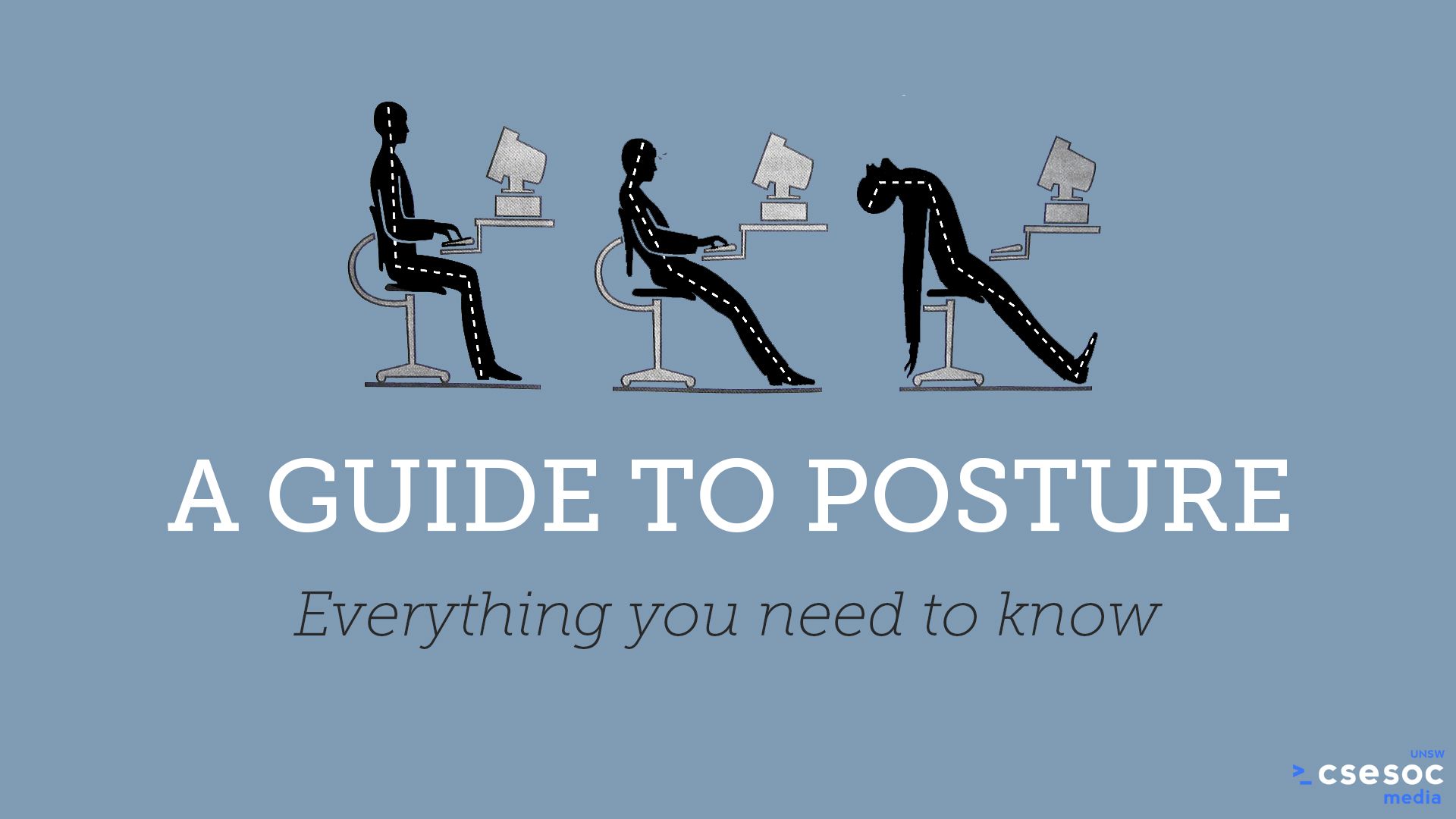A Guide to Posture

Did you know there are serious health implications of prolonged sitting??!
Not going to lie, during quarantine, all I've done is eat, sleep, and go on my laptop. At least during uni I used to walk at least 1,000 steps a day; now the most I walk is my trip to the kitchen.
As a student, intern, future software engineer/office job worker, we're gonna be sitting on our butts for a long… long… time. At least 8 hours a day, 40 hours a week and that’s only including work hours. As CSE students, I’ll assume that we're going to be on our laptops for way longer than that, which means sitting for a prolonged period of time.
How bad is it? You sound like my mum.
But how bad is it?
When you sit, you use less energy than you do when you stand or move. Research has linked sitting for long periods of time with a number of health concerns:
- Muscle degeneration: when you slump in a chair, your abdominal muscles go unused, hip muscles become short and tight, and glutes to nothing. This means poor posture, and overall degeneration of muscles
- Weight: when sitting, our body movement is at a minimum. So if you’re anything like me, and spend all day snacking/YouTubing/coding/studying (i don't relate to the last two but anyways), you're not burning any fat, and the body slows down on its digestion - retaining all that fat and sugar.
3. Back and hip problems: sitting for a prolonged period of time, unless you have amazing posture, results in you slumping and slouching one way or another unconsciously.
- Sitting causes hip muscles to shorten leading to hip joint problems.
4. Neck and shoulders: hunching over your laptop can cause pain and stiffness on your neck and shoulders.
- Did you know leaning into your screen causes forward head syndrome?! Where your neck muscles shorten and thicken causing headaches, arm pains and neck pains
5. Legs and glutes: not using your legs for a long time makes them weak and more likely to injure and strain during exercise.
6. Anxiety and depression: In a three-year survey of 25,000 workers by researchers at Chiba University Japan, it was discovered that repeatedly sitting down in front of a computer for prolonged periods of time can result in depression.
- We don’t understand the links between sitting and mental health as well as we do the links between sitting and physical health yet, but we do know that the risk of both anxiety and depression is higher in people that sit more.
7. Heart disease/attack : this escalated quickly and I'm not even making this up. Sitting for long periods has been linked to heart disease. One study found that men who watch more than 23 hours of television per week have a 64 percent higher risk of dying from cardiovascular disease than men who only watch 11 hours of television a week. A study in the Medicine & Science in Sports & Exercise journal, those of us who sit down for most of the day are 54% more likely to die from heart attacks.
8. Leg problems: Prolonged sitting can cause a build-up of fluid in the leg veins, known as venous congestion or varicose veins. You also have the rare risk of developing a blood clot - deep vein thrombois, which can be deadly if it cuts off blood flow.
So, what do I do now?!
- SIT PROPERLY
- Invest in an ergonomic chair
- Tidy up your workstation and desk and make it ergonomic!!
- Be active (lol)
Today I'm going to talk about an ergonomic chair. Before that though, I'm going to teach you (and myself) how to sit properly.

- Keep an arm's length away from your screen.
- Top of monitor should be level with your eyes
- Sit up straight - STOP SLOUCHING. Keep your shoulders back and relaxed
- Imagine a string pulling on top of your head. Your neck should be relaxed and not hunched forward
- Arms parallel to the floor
- Both feet flat on the ground - this allows correct blood circulation. Avoid crossing your legs :(
Ergonomic Chair
Ergonomic:
Ergonomics is about human engineering. It looks at how objects can be designed to best compliment easy and safe human interaction.
Ergonomic Chair:
An ergonomic chair, for example, is a chair that has been designed to best support the human body, including considerations like posture, comfort, support and health.
However, investing in a good chair only helps if you sit properly.
- Seat height : enough so your feet are flat on the floor. Choose an adjustable chair!
- Seat width and depth: A proper seat depth should leave between 2 and 4 inches between the edge of the seat and the back of your knees. If the seat is too far forward, it may put pressure at the back of the knees. If the chair is not that wide, you lowkey feel like you're sitting on the edge of something.
- Seat tilt: Good ergonomic chairs will allow the seat to tilt, which allows for correct positioning of the pelvis. Anterior pelvic tilt is a posture problem that affects almost everyone who sits a lot, which is why it’s important to keep the pelvis in a neutral position when sitting, with 80 degree angles at the hips, knees and ankles.
- Lumbar Back support: choose a chair that supports the natural S shape of the spine. This prevents slumping, and keeps you supported when you lean back. An adjustable backrest allows users to align the curve in the chair with the curve in their spine, for optimal support. Use a cushion if your chair doesn't have this.
- Backrest recline: allows greater tailored positioning so you can move the backrest to specifically support the natural spine. Use throughout the day allows the backrest to take some of the weight off your upper body, reducing pressure on spinal disks and muscles
- Swivel: chair go swrrrrrrrr for easy manoeuvrability.
7. Armrests: reduce tension in the supper body and allow shoulders to relax. But!! Don't use it when typing as this reduces overall arm movement -> increases wrist movement -> strain on forearm muscles
8. Headrest: supports the back of the head and upper neck, reducing tension in shoulders and upper torso
9. Materials: hard wooden/plastic chairs will be uncomfortable to sit on overtime. The material shouldn't cause you to sweat either!
10. Wheels: If your chair will be used on a hard surface, find a chair with soft rubber wheels. If your workplace/home office is carpeted, opt for hard wheels to help you navigate better
Feeling attacked? It’s alright, I personally felt attacked whilst writing my own article. Well, here for a good time not a long time.
- Rosanna
References:
https://www.jasonl.com.au/blogs/main/ten-ergonomic-tips-for-an-ergonomic-work-station-and-office-chair
https://www.chairoffice.co.uk/blog/the-ergonomics-of-a-chair-explained/
https://www.mayoclinic.org/healthy-lifestyle/adult-health/in-depth/office-ergonomics/art-20046169
The dangers of sitting: why sitting is the new smoking - by Victorian Government
https://www.ncbi.nlm.nih.gov/pmc/articles/PMC3404815/
https://www.cancer.org/latest-news/sitting-time-linked-to-higher-risk-of-death-from-all-causes.html
https://www.betterhealth.vic.gov.au/health/healthyliving/the-dangers-of-sitting
